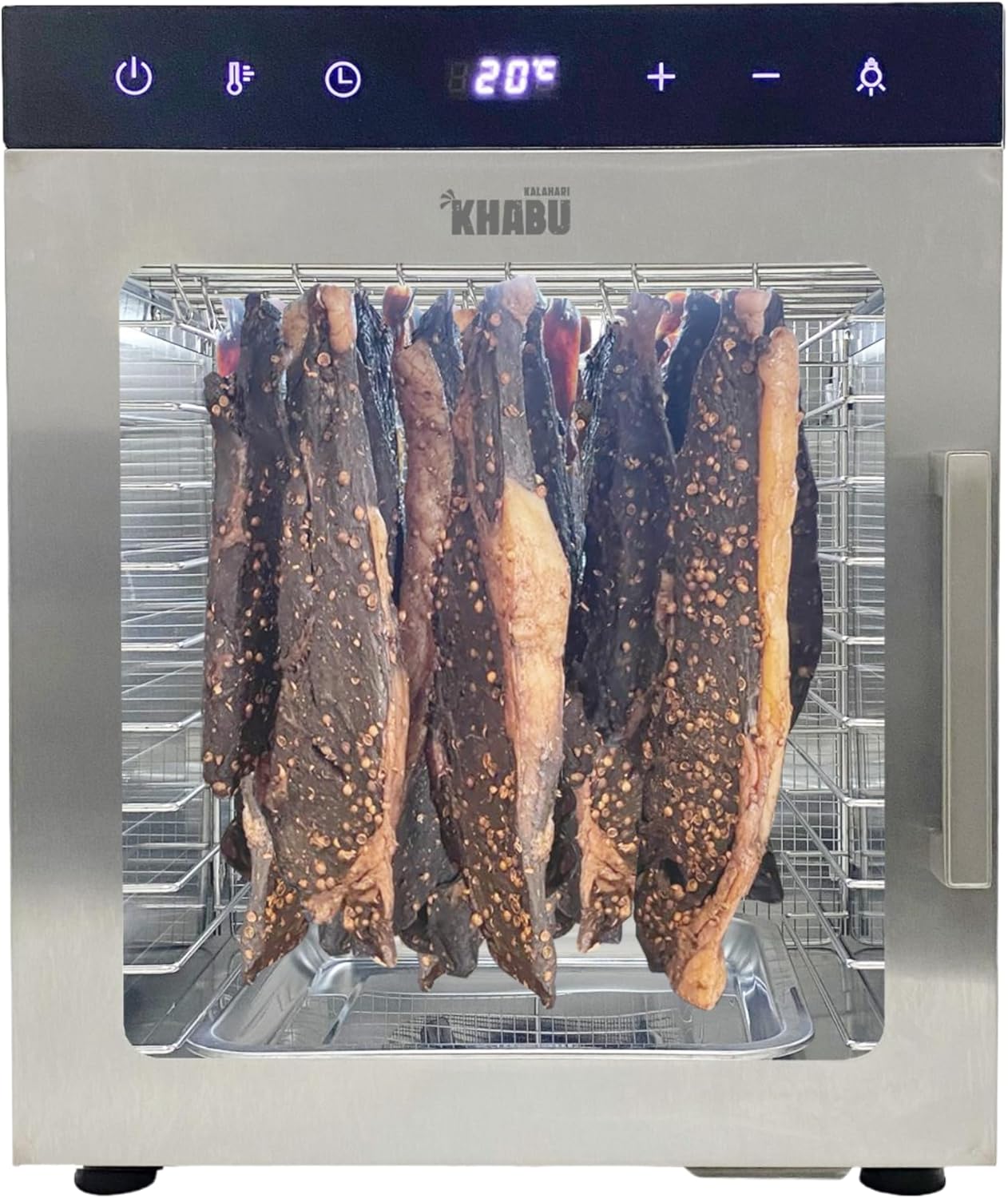Dehydrating food is a time-honored preservation method, locking in flavor and extending the shelf life of various ingredients. In particular, meat dehydration has a rich history across cultures, with biltong being a treasured snack originating from Southern Africa. Unlike jerky, which is often smoked and cured with sugar, making biltong involves air-drying meat in strips, seasoned with a blend of spices and vinegar for a distinctive taste. The result is a savory treat that is chewy and packed with protein.
The process of making biltong at home has been made simpler with the advent of specialized biltong dehydrators. These appliances provide the perfect environment for drying meat evenly and safely, giving you the ability to craft homemade biltong to your taste preference. When selecting a biltong dehydrator, the critical factors to consider include the unit’s airflow circulation, temperature control, size, and any additional features that accommodate the thickness of your meat cuts.
Ensuring that the dehydrator is made from food-safe materials is paramount, as you want to avoid any potential contamination of your biltong. Furthermore, a dehydrator with an easy-to-clean design will save you time and maintain a hygienic drying process. After conducting a thorough examination of various models and considering the essential elements of temperature and airflow, we have identified the top biltong dehydrators that provide exceptional results. Our assessments will help you find a dehydrator that not only performs efficiently but also matches your specific biltong-making needs.
Top Biltong Dehydrators
We’ve carefully selected the finest biltong dehydrators on the market, each with features to suit different drying needs and preferences. Our roundup addresses functionality, durability, and value, helping you make an informed decision for your homemade biltong creations.
Kalahari Khabu Biltong Boss

We believe the Biltong Boss is a solid choice for DIY food dehydrating enthusiasts, especially those keen on making biltong at home.
Pros
- Low starting temperature of 68 Fahrenheit ideal for biltong
- Large capacity with 10 trays and 36 hooks
- Precise digital temperature and timer controls
- Versatile functionality for various foods
- Quiet operation with a substantial capacity
Cons
- Not dishwasher safe, requiring manual cleaning
- May need to shuffle trays for even dehydration
- Advanced features may come with a price tag that isn’t ideal for all budgets
- Limited to a 24-hour timer
- Slight learning curve for optimal use
Having put the Biltong Boss to the test, we discovered its lower starting temperature of 68°F is a real game-changer for making authentic biltong. The 10 trays and 36 hooks provide ample space to dry large batches of your favourite snacks. Our experience also revealed that the stainless-steel design not only gives a premium feel but makes cleaning straightforward.
The digital interface provides precise control over temperature and timing. We noticed it was a breeze to use, even for someone who isn’t tech-savvy. Eating biltong made with the Biltong Boss had us tasting the meticulous craftsmanship and flavor that can only be achieved through careful, low-temp dehydration.
While we enjoyed the quiet operation, ensuring a peaceful kitchen environment, we observed a couple of minor drawbacks. Given that it’s not dishwasher-safe, you’ll need to dedicate some time for manual cleaning. Also, those marathon dehydration sessions are off-limits due to the 24-hour timer cap. Initial setup may require a bit of patience as you learn the ropes, but rest assured that the end result is worth the effort.
Magic Mill Pro Dehydrator

We think the Magic Mill Pro Dehydrator is the ideal choice for anyone serious about dehydrating a wide variety of foods with ease and precision.
Pros
- Consistent drying with no need to rotate trays
- User-friendly digital controls with automatic shut-off
- Versatile with 7 spacious stainless steel trays
Cons
- Takes up significant counter space
- May be an investment for casual users
- Can be loud during operation
Having used this dehydrator to create everything from beef jerky to dried fruits, we’ve found it to be an exceptionally reliable machine. The rear-mounted fan deserves a special mention, as it distributes heat evenly across all trays, providing consistent results without having to shuffle them around mid-process. This practical feature not only saves time but also eliminates the risk of unevenly dried batches.
The digital thermostat and timer on this unit afford us a level of precision that’s reassuring when dehydrating foods that require specific temperatures. Its automatic shut-off is a welcome safety feature that kicks in once the timer is done, providing peace of mind, especially when leaving the dehydrator unattended. We’ve also appreciated the ‘Keep Warm’ function, as it allows for food to stay at the perfect temperature until we’re ready to store it.
Cleanup is a breeze with the Magic Mill Pro Dehydrator. After spending hours making healthy snacks, the last thing we want to do is spend a long time tidying up. Thankfully, all the trays are dishwasher safe, drastically cutting down on our cleaning time. It’s clear this machine is designed with user convenience in mind.
Overall, from its sturdy build to its thoughtful features, this dehydrator stands out for its superior performance in our kitchen. It is a solid investment for those of us who frequently enjoy the benefits of dehydrated foods.
B&T SAHARA Dehydrator

We think the B&T SAHARA Dehydrator is a solid choice due to its convenience, quality output, and innovative space-saving design.
Pros
- Collapses easily for compact storage
- Large drying area with precision controls
- High-quality, filtered airflow system
Cons
- Slightly higher price point
- Trays may allow smaller items to fall through
- 120V only, which may limit its use in some regions
After putting the SAHARA Dehydrator through its paces, we were struck by the sheer convenience of the foldable design. It’s rare to find such a space-efficient machine that doesn’t sacrifice performance. The dehydrator expands to a considerable size, offering ample room for large batches of biltong, yet it folds down just as advertised—quickly and easily to a fraction of its expanded size, making it perfect for our smaller kitchen.
The dual heat and time settings were a delight, providing both a high-powered initial drying burst and a lower temperature phase to lock in nutrition and flavor—a feature not found on many models. The glass doors and stainless steel shelves exude a premium feel and make monitoring the process a breeze without constantly opening the unit, which can lead to heat loss in others we’ve used.
The filtered air system is another highlight, giving us peace of mind that our biltong is drying with clean air, enhancing the final taste. It’s quiet, too, something our ears appreciated after experiences with other dehydrators that could be heard in the next room.
Admittedly, the cost may be a consideration for some, as it comes at a premium. Yet, for those serious about dehydration, the investment aligns with the unit’s features and results. We did observe that smaller items could slip through the shelf gaps. While not an issue for biltong, this is something to keep in mind if planning to dehydrate a variety of smaller foods. Lastly, being designed for use only at the standard North American voltage of 120V may limit its versatility in other parts of the world. However, for our use in the US, it was a non-issue.
Despite these minor drawbacks, the SAHARA Dehydrator left us pleased with its performance. We confidently recommend it to others looking for an efficient, top-tier dehydrator that marries function with convenience.
Buying Guide
When selecting a biltong dehydrator, it’s important we focus on certain key features that ensure efficiency and quality of the final product.
Capacity & Size
- Assess our space to decide the size of the dehydrator.
- Ensure it has enough capacity to meet our biltong-making needs.
Temperature Control
- Look for precise temperature settings to properly cure meat.
- Consistent heat distribution is crucial for even dehydration.
Materials & Durability
- Prefer stainless steel for longevity and ease of cleaning.
- Check for BPA-free components if plastic is involved.
Ease of Use
- Digital controls can simplify the dehydration process.
- Timer functionality allows for better time management.
| Feature | Why It Matters |
|---|---|
| Adjustable Shelves | Accommodate different meat thicknesses |
| Airflow | Ensures even drying of biltong |
| Easy to Clean | Maintains hygiene and saves time |
Additional Features
- Look for dehydrators with a fan, which is better for air circulation.
- Removable trays or racks enhance cleaning and storage flexibility.
By focusing on these features, we can make a well-informed decision that satisfies our biltong-making requirements.
Frequently Asked Questions
In our guide to making biltong with a dehydrator, we’ll address common queries related to temperature settings, drying times, suitable dehydrator models, adapting recipes for different appliances, and the comparison between dehydrators and traditional biltong boxes.
What temperature should I set my dehydrator to for making biltong?
For optimal biltong drying, we recommend setting your dehydrator to a temperature range of 60-70°C (140-158°F). This strikes a balance between preserving the meat’s flavor and ensuring food safety.
What is the optimal drying time for biltong in a dehydrator?
The drying time for biltong in a dehydrator typically ranges from 4 to 12 hours. The exact time can vary based on the thickness of the meat slices and your personal preference for dryness.
Which dehydrator is best suited for making biltong?
While any reliable dehydrator with a temperature control feature is suitable for making biltong, models with a built-in fan for even air flow tend to yield the best results. Look for dehydrators designed for jerky and meat products.
How can I adapt a biltong recipe for use in an air fryer dehydrator?
To adapt a biltong recipe for an air fryer dehydrator, reduce the cooking temperature to the dehydrator’s equivalent and extend the drying time accordingly. Keep a closer eye on the meat, as air fryer dehydrators can dry it faster than traditional models.
Is there a significant difference between using a dehydrator and a traditional biltong box?
Yes, there are notable differences. A dehydrator provides a controlled environment with consistent temperature and airflow, potentially reducing drying time and mitigating the risk of spoilage compared to a traditional biltong box, which relies on natural air flow and ambient temperatures.
Can I use a dehydrator to cure meat, similar to making biltong?
A dehydrator can indeed be used to cure meat similarly to biltong. The key is in the preparation; curing salts and proper seasoning are essential before dehydration to ensure both flavor and safety.

